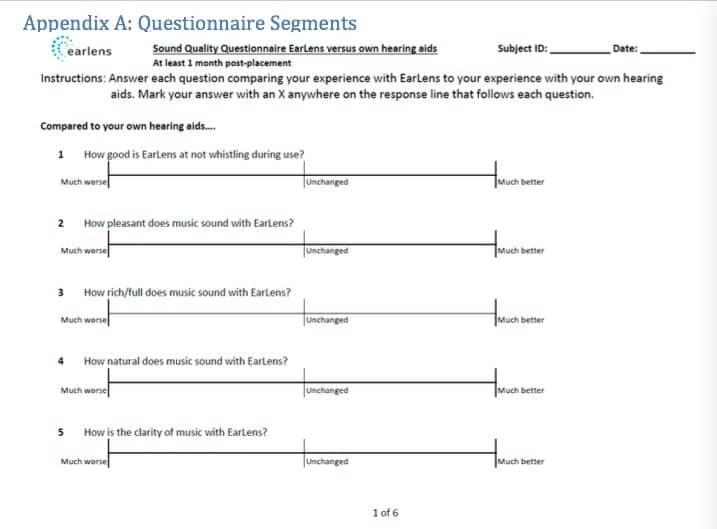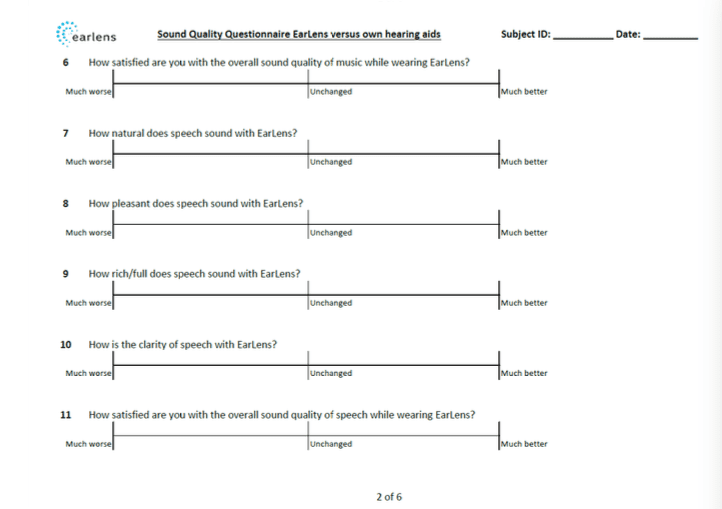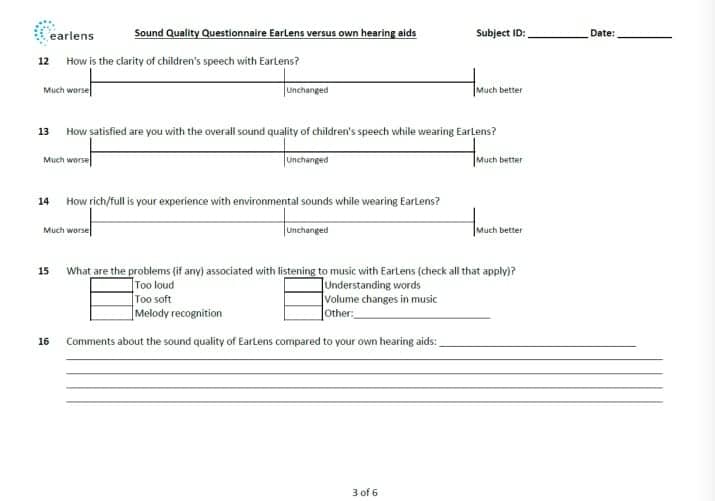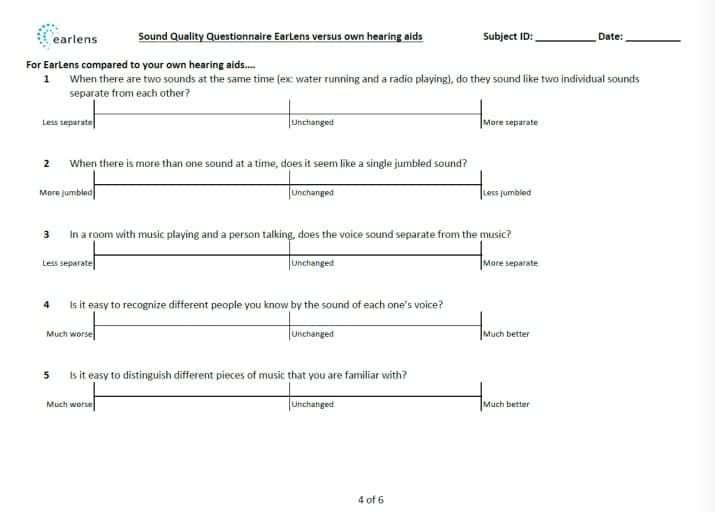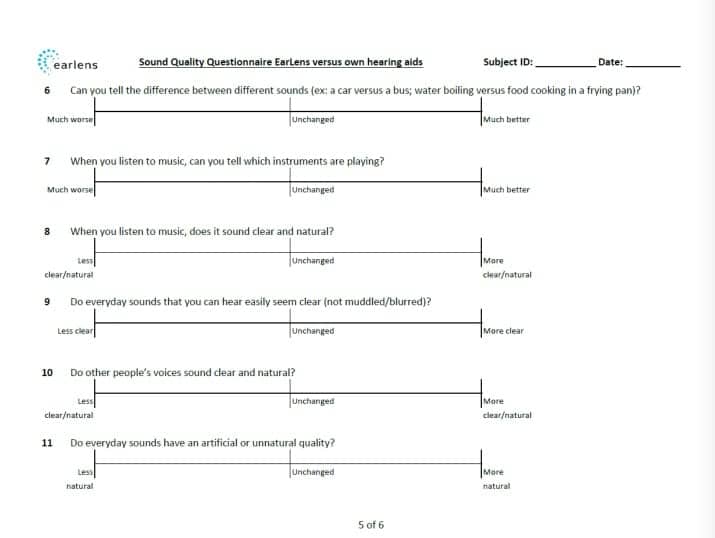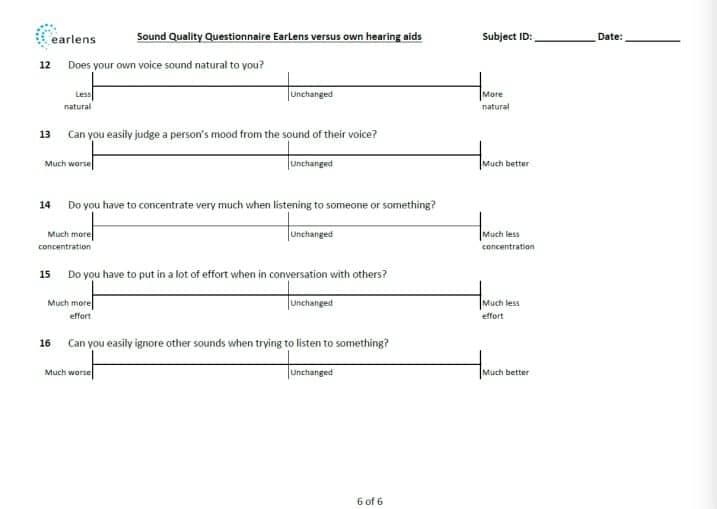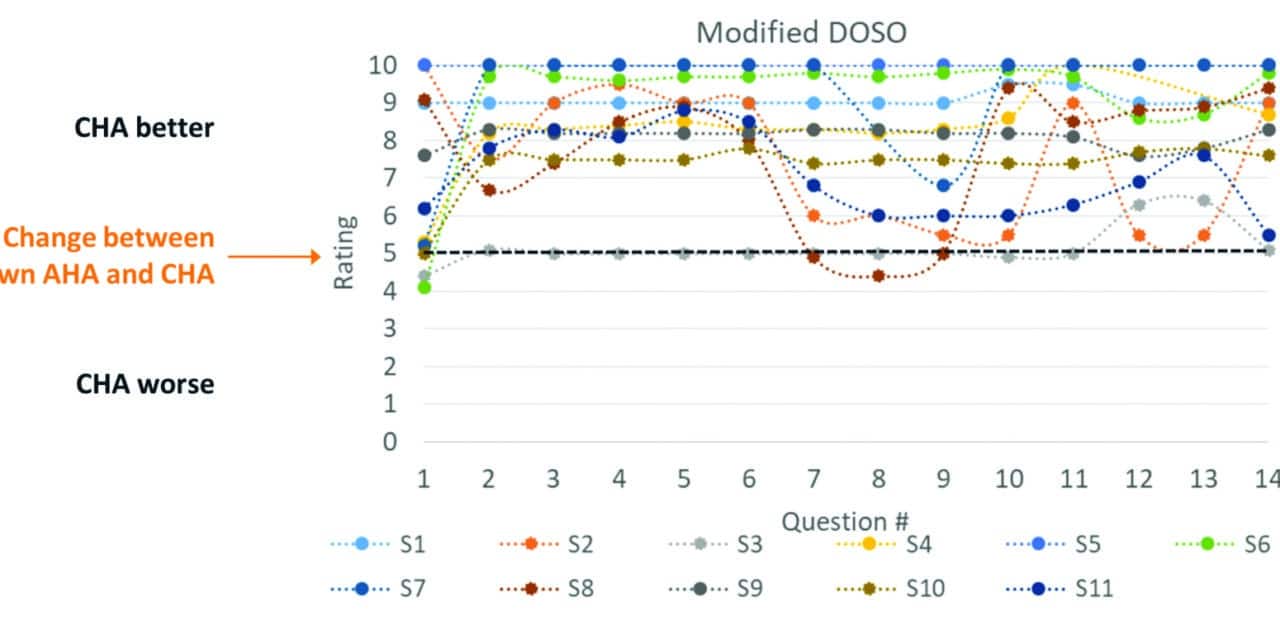Tech Topic | February 2020 Hearing Review
By Tanya Arbogast, ScD, and Suzanne Carr Levy, PhD
The Earlens Contact Hearing Solution has been shown to deliver greater audibility across an extended frequency range than conventional aids, but do patients notice the difference? A pilot study using a new questionnaire was run with experienced hearing aids users to evaluate the subjective sound quality they had when fit with the Earlens Contact Hearing Solution versus when they were switched back to their own acoustic hearing aids.
There is mounting evidence to suggest that an extended bandwidth provides more natural sound quality and better speech understanding in complex environments.1-5 It has been demonstrated in hearing-impaired listeners that as the bandwidth increases, subjective ratings of naturalness increase and listening preference increases.6,7
Some acoustic hearing aids (AHAs) claim bandwidth capabilities of up to 10 kHz, but due to physical limitations and realistic fitting practices, these devices usually roll off in audible bandwidth beyond ~5 kHz.8 Therefore, a Contact Hearing Aid (CHA), which has been demonstrated to provide extended bandwidth of amplification to 10 kHz for up to severe losses,9,10 may be a good option for experienced hearing aid users seeking an improved sound quality experience.
As the CHA requires a bit more effort to fit clinically (it requires an ENT to place the Lens component of the device which contacts the eardrum) than an AHA, a common question clinicians ask is, “Will my patients notice the difference between an AHA and a CHA in a meaningful way?” and “How can I demonstrate the value that this high-end device offers?” Consequently, a subjective questionnaire was developed to capture sound quality outcomes in a typical clinical setting and provide more controlled evidence of improved sound quality with extended bandwidth.
The Earlens Contact Hearing Solution has no acoustic output—it directly drives the eardrum via a custom-made Lens. A recent change to the product, switching from a light-based to an inductive method of energy and signal transfer from the Ear Tip to the Lens, has made the system less sensitive to positional alignment while maintaining the broad spectrum performance. (For more information, see the Earlens website as well as a subsequent article scheduled for the April Hearing Review.)
Questionnaire Development
High-quality research has led to the development and validation of several subjective questionnaires shown to be useful in either demonstrating clinical improvement on an individual basis (COSI, APHAB, DOSO),or on a population basis (SSQ). Most assessments reliably demonstrate benefit relative to unaided listening (APHAB). Two questionnaires have previously distinguished between different hearing aid technologies.12,13 In Rawls et al,12 the Speech and Spatial Qualities of hearing sub-scale (SSQ) showed a difference between the Widex Dream and other acoustic hearing aids. Using Device Oriented Subjective Outcome Scale (DOSO), Chasin13 showed a significant difference between acoustic hearing aids with different input dynamic ranges.
As with many emerging technologies, new instruments must be developed that are sensitive to the benefit proposed by the new technology. A subset of questions specifically related to sound quality were selected, 16 items from the SSQ14 and 14 items from the DOSO,15 for a total of 30 questions. The response scale was modified from a Likert (DOSO format) to a continuous response scale, similar to the SSQ-C, with the anchors “much worse,” “unchanged,” and “much better” designed to elicit direct comparisons between different devices. The result was a questionnaire that would allow for a subjective sound quality comparison of two technologies (see Appendix A at the end of the article).
Methods & Procedures
A pilot clinical study was conducted with 11 volunteer participants to determine if this questionnaire was sensitive to sound quality improvements provided by the CHA compared to their prior as-found acoustic aids. The study design was intended to mimic a commercial clinic flow, going from the AHA to the CHA, with the questionnaire being administered after about 6 weeks of acclimatization to the CHA (Timepoint 1). For the purpose of the study, the subjects were required to revert back to their acoustic hearing aid for 1 week prior to completing the questionnaire again to see if the outcomes persisted after returning to their prior amplification condition (Timepoint 2). Participants were required to meet the indications for use for the CHA bilaterally, as well as the following additional criteria:
- Greater than or equal to 70% on supra-threshold word recognition in each ear,
- Able to read and speak English,
- Current user of bilateral acoustic hearing aids in good working order as-found and determined by the clinician’s discretion using real-ear measurements to be reasonably well fit.
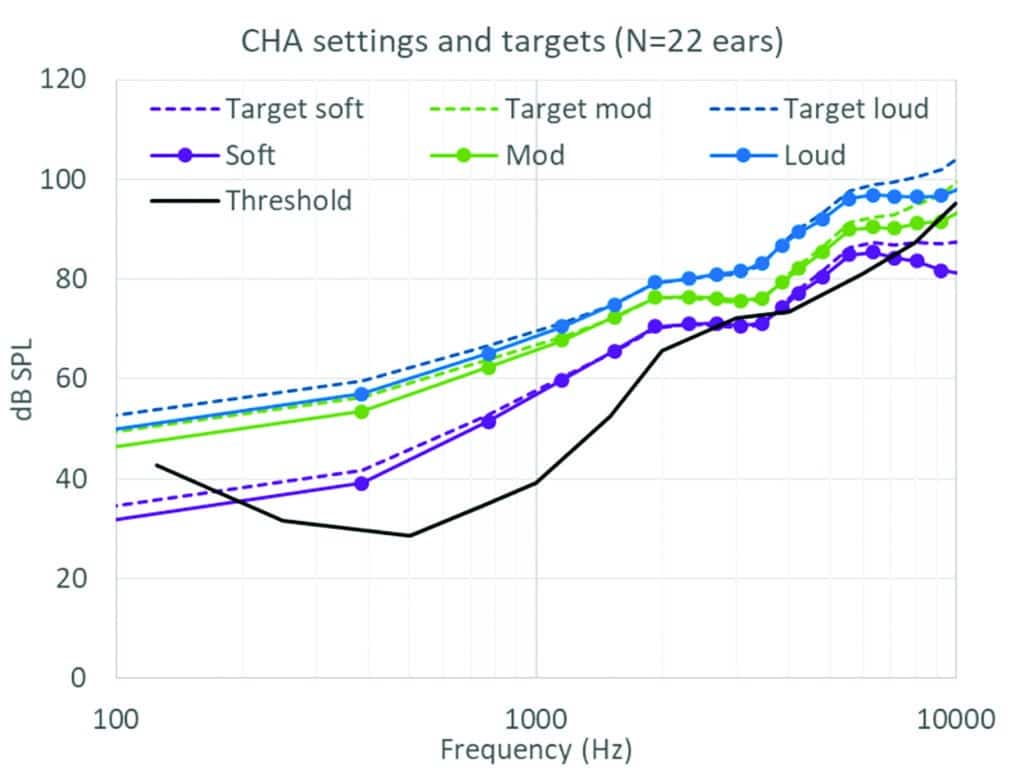
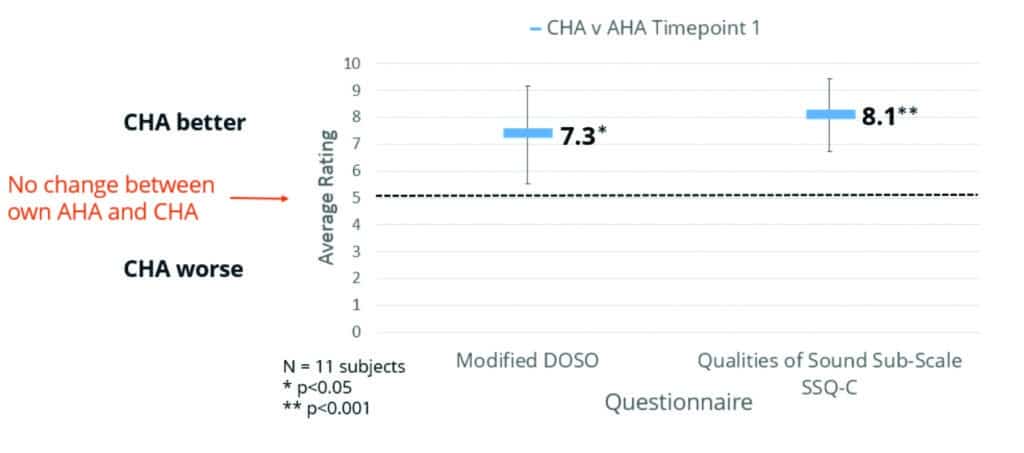
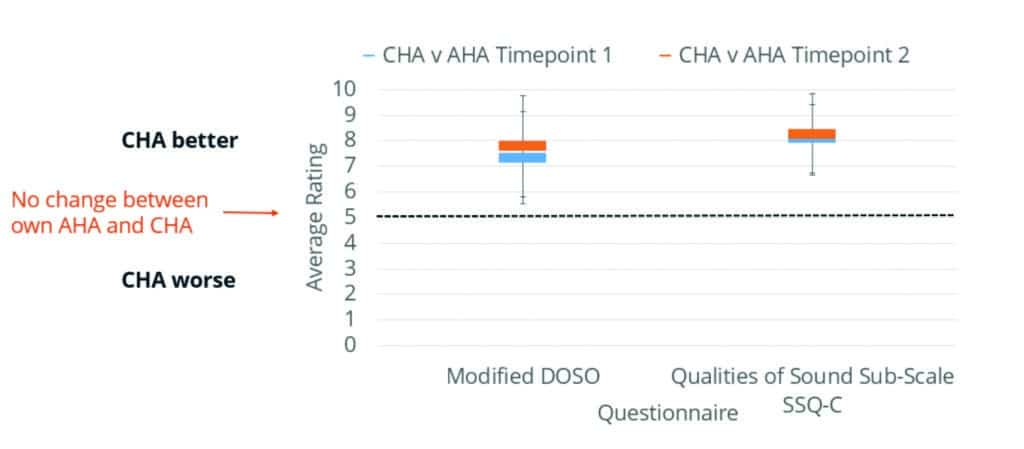
Using real-ear measures, the average audible bandwidth of the as-found AHAs was ~4 kHz. This is consistent with the real-world experience of fitting and adjusting hearing aids, and provides the reference bandwidth condition to the CHA, which showed average audible bandwidth to 10 kHz (Figure 2).
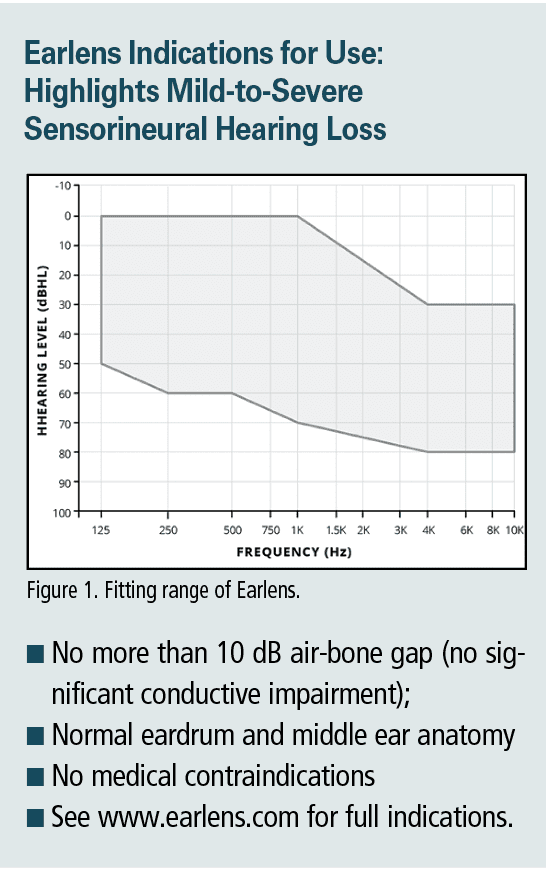
Average Results
Both questionnaire segments were sensitive to the AHA/CHA technology comparison (Figure 3), and each questionnaire showed a statistically significant improvement in mean sound quality ratings for the CHA compared to their own AHA.
Furthermore, the effect persisted after subjects returned to their prior amplification condition at Timepoint 2, suggesting reliability of the questionnaire (see Figure 4).
Individual Results
On an individual subject basis, average ratings on each of the questionnaire segments ranged fairly widely from near “Unchanged” to “Much Better” (see Figure 5, where lines connect the average ratings for each subject). Subjects who rated the CHA higher on the modified DOSO also tended to rate it more highly on the SSQ sub-scale. However, there were a few subjects with noticeably lower average ratings on the SSQ than the modified DOSO (dotted lines in Figure 5), which may indicate that the two questionnaires probe different aspects of sound quality.
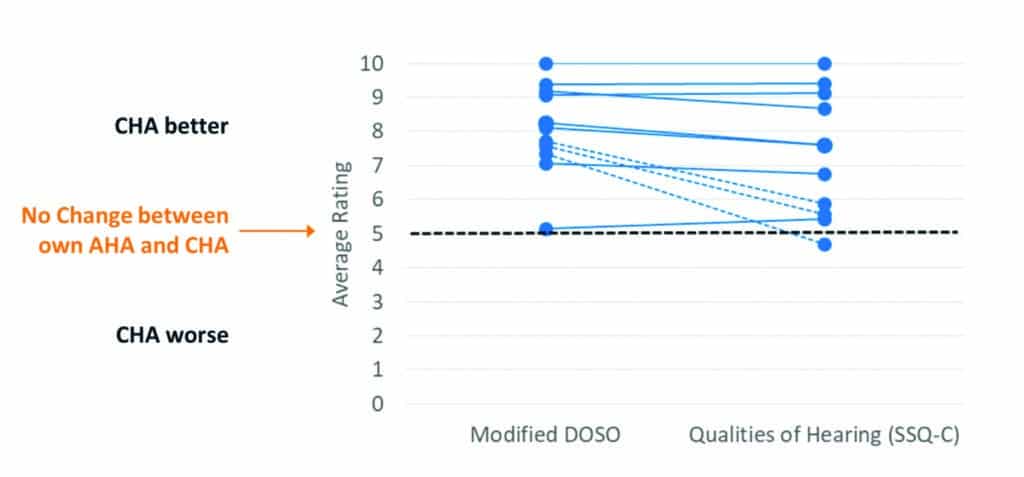
Interestingly, although the sample population was small, the three lowest average ratings for SSQ in Figure 5 were subjects with frequency lowering technology in their acoustic devices, and thus, in a way, they were comparing to another device which provided some access to information reflecting wider bandwidth amplification—and thus smaller subjective differences might be expected on this questionnaire.
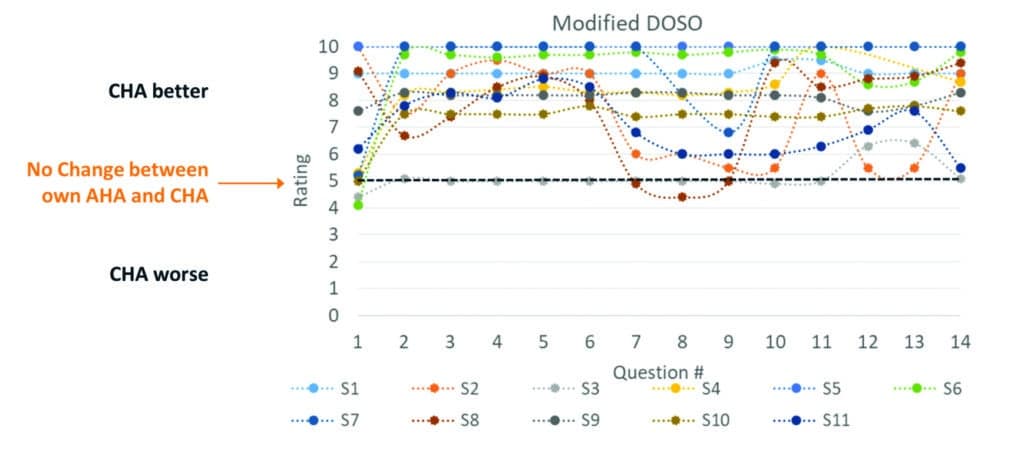
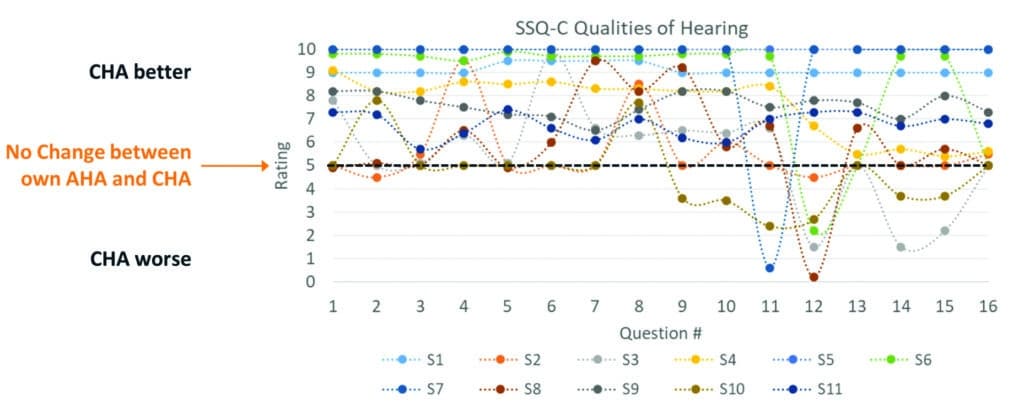
Examining individual questions, it can be seen that while many subjects responded very consistently across questions, there were some responders who varied more widely depending on the specific question (Figures 6a-b). In addition, the SSQ Qualities of Hearing sub-scale seems to produce a wider range of responses than does the Modified DOSO. The specific questions with more response variability include:
1) Do everyday sounds have an artificial or unnatural quality? (Question 11)
2) Does your own voice sound natural to you? (Question 12)
3) Do you have to concentrate very much when listening to someone or something? (Question 14)
4) Do you have to put in a lot of effort when in conversation with others? (Question 15)
Administration of the Questionnaire in a Clinical Setting
On an individual patient basis, this questionnaire can be administered after the patient has appropriately acclimatized to the device. After determining with the patient which aspects of sound quality are a priority for improvement when upgrading to new technology, the response profile can be used to show the benefits achieved or to pinpoint areas that may need attention (eg, programming adjustment, counseling, or use of assistive technology).
Summary
In summary, the Earlens Contact Hearing Aid allowed fitting with much greater access to extended bandwidth of sound than the comparison acoustic hearing aid, and the questionnaire results demonstrated measureable differences in sound quality perception between the two technologies. The questionnaire appears to be sensitive to measuring the subjective benefit of increased bandwidth of audibility—and is short enough to be used clinically. Such subjective measures can help you clinically to determine if the additional information that the device provides is detectable and useful to your individual patients.
Visit www.earlens.com for more information, instructions for use, and links to instructional videos.
References
- Carlile S, Schonstein D. Frequency bandwidth and multi-talker environments. Paper presented at: 120th Audio Engineering Society (AES) Convention; May 20-23, 2006; Paris, France. http://www.aes.org/e-lib/online/browse.cfm?elib=13603.
- Turner CW, Henry BA. Benefits of amplification for speech recognition in background noise. J Acoust Soc Am.2002;112(4):1675-1680.
- Hornsby BWY, Ricketts TA. The effects of hearing loss on the contribution of high- and low-frequency speech information to speech understanding. J Acoust Soc Am. 2003;113:1706–1717.
- Plyler PN, Fleck EL. The effects of high-frequency amplification on the objective and subjective performance of hearing instrument users with varying degrees of high-frequency hearing loss. J Speech Lang Hear Res. 2006;49(3):616-627.
- Levy, SC, Freed DJ, Nilsson M, Moore BCJ, Puria S. Extended high-frequency bandwidth improves speech reception in the presence of spatially separated masking speech. Ear Hear. 2015;36(5):e214–e224.
- Ricketts TA, Dittberner AB, Johnson EE. High-frequency amplification and sound quality in listeners with normal through moderate hearing loss. J Speech Lang Hear Res. 2008;51(1):160-172.
- Brennan MA, McCreery R, Kopun J, et al. Paired comparisons of nonlinear frequency compression, extended bandwidth, and restricted bandwidth hearing-aid processing for children and adults with hearing loss. J Am Acad Audiol. 2014.25(10):983-998.
- Struck CJ, Prusick L. Comparison of real-world bandwidth in hearing aids vs Earlens Light-driven Hearing Aid System. Hearing Review.2017;24(3):24-29.
- McElveen J, Gantz B, Perkins R, et al. Overcoming high-frequency limitations of air conduction hearing devices using a LIGHT-DRIVEN contact hearing aid. Poster presented at: The Triological Society, 120th Annual Meeting at the Combined Otolaryngology Spring Meetings (COSM); April 26-30, 2017; San Diego, California. https://www.researchposters.com/display_posters.aspx?code=COSM2017.
- Dundas D, Levy SC. The Earlens Light-Driven Hearing Aid: Top 10 questions and answers. Hearing Review.2018; 25(2):36-39.
- Abrams HB, Kihm J. An introduction to MarkeTrak IX: A new baseline for the hearing aid market. Hearing Review. 2015;22(6):16-21.
- Rawls S, Weiner J, Nunes R, MacDonald O. A clinical evaluation of sound quality in hearing aids. October 20, 2014. https://www.audiologyonline.com/articles/clinical-evaluation-sound-quality-in-13019.
- Chasin, M. A novel technique to improve amplified sound quality for both music and speech. Hearing Review. 2017;24(8):32-36.
- Gatehouse S, Noble W. The Speech, Spatial and Qualities of Hearing Scale (SSQ). Int J Audiol.2004;43(2):85-99.
- Cox RM, Alexander GC, Xu J. Development of the Device-Oriented Subjective Outcome (DOSO) scale. J Am Acad Audiol.2014;25(8):727-736.
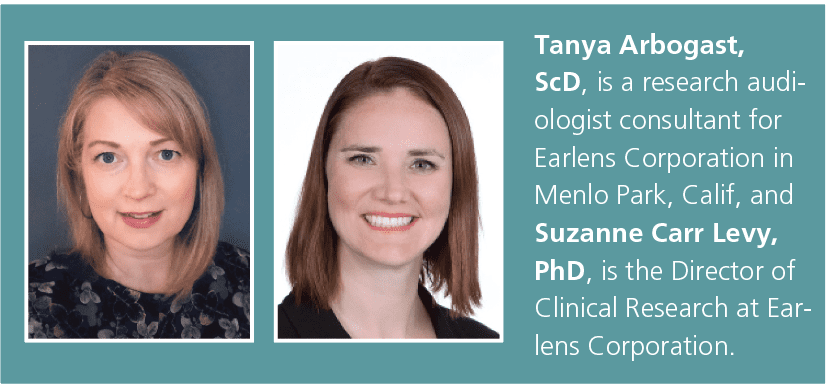
CORRESPONDENCE can be addressed to HR or Dr Levy at: [email protected]
Citation for this article: Arbogast T, Levy SC. A questionnaire to assess the subjective benefit of extended bandwidth amplification hearing aids. Hearing Review. 2020;27(2):24-26.
Appendix
